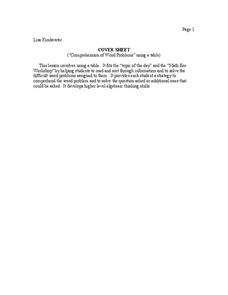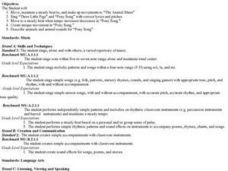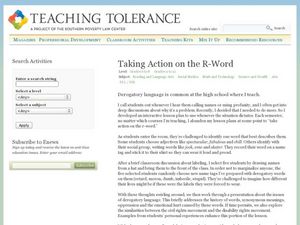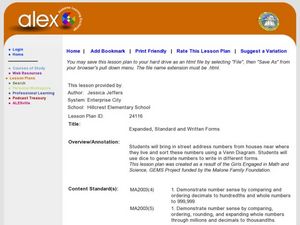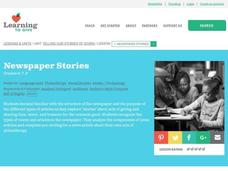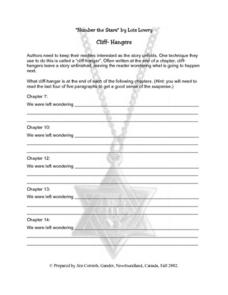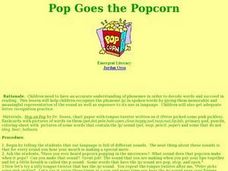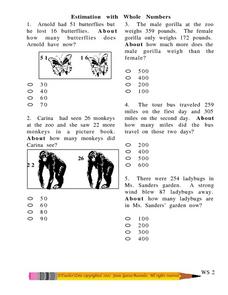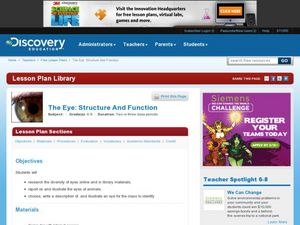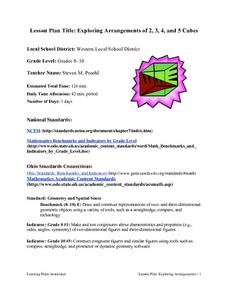Curated OER
"Comprehension of Word Problems" Using a Table
Sixth graders practice solving math problems by utilizing a data table. In this number sense activity, 6th graders create a table using the numerical information about a fictitious farm's inventory. Students complete the empty segments...
Curated OER
Fraction Models
Third graders make models of fractions and mixed numbers. Using fraction strips and drawing pictures, 3rd graders develop conceptual understanding of the equivalent forms. Students use the number line to represent and compare...
Curated OER
The Pony Song
Pupils sing "Three Little Pigs", the "Pony Song", and "The Animal Blues" in this elementary school music lesson. National and State Standards are addressed. Assessment rubric is included for grading and student evaluation.
Curated OER
Teaching Tolerance: Taking Action on the R-Word
Students explore the use of derogatory language and labeling others. In this discrimination lesson students research word origins, how different terms came to be used in a negative sense and what it would be like to have a negative label...
Curated OER
Expanded, Standard and Written Forms
Students explore expanded, standard, and written forms of numbers. In this number sense lesson, students examine the various ways of writing numbers as they complete a Venn diagram activity.
Curated OER
Newspaper Stories
Students examine the structure of the newspaper. In this newspaper lesson, students look at the different types of articles about giving, sharing, and acts for the common good. They realize the types of voice that are used in the...
Curated OER
Enjoyable Assessments
First graders participate in two place value games for review. In groups, they work together to assess themselves before their test over place values. They review any questions they have before their assessment.
Curated OER
Colonial Research Fun
Students review the characteristics of the thirteen colonies. In groups, they use the internet to research one of the colonies more in depth and answer questions about it. They develop a newspaper or travel brochure to share the...
Curated OER
I Read On My Own!
Students examine how to choose books to read on their own and how to participate in reading discussions. They practice the two finger rule for choosing an independent reading book and how to look at the book's topic for personal...
Curated OER
The Cliffhangers
In this language arts worksheet, students examine the different parts of the story Number the Stars. They use the graphic organizer to keep track of the thoughts.
Curated OER
POP! Goes the Popcorn!
Students complete a variety of activities based on examining corn and popcorn as one of the major crops of Kansas. They journal the results of the multidisciplinary activities in this unit.
Curated OER
Favorite and Alarming Sounds
Students target which sounds can warn us of danger. Several objects are hidden behind a box or board. They have to listen to the sounds each object makes and guess what it is. They then make a graph of the number of students that prefer...
Curated OER
Estimation With Whole Numbers
In this elementary math worksheet, students find the answers to the 10 problems written in the multiple choice format in order to develop critical thinking skills.
Curated OER
Objects Vibrate
Young scholars strike a tuning fork and dip it in water. They sprinkle cereal flakes on a drum, than tap the top of the drum. Students stretch a rubber band between two fingers and pluck it; stretch the elastic farther and pluck it...
Curated OER
Writing and Graphing Functions
Students explore mathematics by completing a graphing assignment in class. In this math functions lesson, students practice graphing X and Y coordinates on a graph and checking their work with partners. Students complete more graphing...
Curated OER
Adding Integers with Counters
Students add integers and use counters to create a visual. In this algebra instructional activity, students work in pairs as they use the computer to add integers. They complete an assessment on adding integers at the end of the activity.
Curated OER
Would You Believe Your Eyes?
Students study the parts and functions of the human eye. They create dodecagons which are twelve-sided figures with twelve equal angles and share these with the class so that each student can begin to see how many different illusions can...
Curated OER
A Taste of Our Classroom
Students explore their classroom tastes. In this lesson plan, students list the four tastes that the tongue can detect, map the individual areas of taste on the tongue, and demonstrate the ability to identify objects through the use of...
Curated OER
The Eye; Structure and Function
Students research the structure and function of the eye. In this anatomy lesson, students write a report about the eye and draw an illustration. They research a particular animal's eye then present their findings to the class without...
Curated OER
Number and Number Relations: Lesson 2
Eighth graders recognize or compute decimal equivalents of fractions. They recognize or compute the percent equivalent of decimal fractions. They relate fraction, decimal, and percent equivalents and recognize decimal equivalents.
Curated OER
Do You Have Number Sense?
Seventh graders are grouped according to their ability level with a captain who is elected by the students in that particular group. Students demonstrate their knowledge of rational and irrational numbers by defining them. Students use a...
Curated OER
Basic Sense
Fifth graders add fractions. After a class discussion on real life application of fractions, the teacher uses fractions strips to model adding fractions. In pairs, 5th graders model adding fractions by drawing diagrams. They justify...
Curated OER
Money Sense
Pupils identify the value of quarters, dimes, nickels, and pennies, and use a variety of coins to show the value of a dollar. They count the exact amount of purchase.
Curated OER
Exploring Arrangements of 2, 3, 4, and 5 Cubes
Young scholars construct models of various tricubes, tetracubes, and pentacubes that are possible, classify n-cubes into different groupings, and draw these figures on isometric dot paper giving true perspective to what they visualize.
